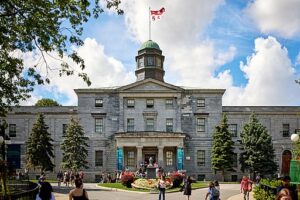The Problematic Federal Cap on International Students: An Interview with Professor Tari Ajadi
 "Show the Way" by Best Canada Immigration Consultants in Jaipur is licensed under CC BY 2.0.
"Show the Way" by Best Canada Immigration Consultants in Jaipur is licensed under CC BY 2.0.
In September 2024, Marc Miller, the former immigration minister, unveiled new limits for international students. Study permits were to decrease by 35% that year, followed by a further 10% deduction in 2025 to just 437,000. This policy was supposedly aimed at solving the issue of overwhelming numbers of international students at Canadian colleges, specifically in Ontario. However, a deeper look at the policy reveals that it only exacerbates the issue. Instead of addressing the root causes, the 2024 restrictions have sparked a nationwide crisis for post-secondary institutions across Canada.
These policies were created because of overpopulation in Ontario, which attracts the most international students. When announcing the policy, Miller targeted private institutions in Ontario, saying that “some of the really, really bad actors are in the private sphere, and those need to be shut down, but there is responsibility across the board.” Further, he declared that “we just need the provinces in question, in this case, Ontario, to assume their responsibility” to better monitor the conditions of international students and the communities in which they settle.

He has also justified the policy by claiming that international students are abusing the asylum system. Yet data from the Immigration and Refugee Board of Canada shows that the share of international students claiming asylum has been decreasing. International students have also been broadly blamed for housing shortages and the severe strain on the healthcare system. Additionally, they are seen as prioritized over domestic students, as their higher tuition fees generate more revenue for universities.
The federal government’s response has followed a similar line of reasoning, defending the policy as a necessary measure to relieve pressure on housing, healthcare, and other public services. As part of these changes, international students are now required to demonstrate greater financial stability – with the Guaranteed Investment Certificate (GIC) amount doubling from $10,000 to $20,635.
The effects of the cap are already rippling through post-secondary institutions, prompting widespread adjustments. This has been especially evident in Ontario, where the changes have brought both positive and negative consequences. This past November, Sheridan College paused 40 programs, while Seneca College announced it would close its Markham campus due to declining enrollment. These disruptions reflect the policy’s intention to scale back college resources – particularly at institutions like Sheridan and Seneca, which enrol a high number of international students.
However, the cap extends to all post-secondary institutions across the country – and this is where the problem lies. The Council of Ontario Universities has projected that its 20 member universities will collectively lose $330 million in the 2025 fiscal year, and $600 million the following year. In 2022-23, international tuition brought in over $2.3 billion for Ontario’s 24 publicly funded colleges –accounting for roughly one-third of their total revenue. The initial $330-million shortfall has triggered a funding crisis not only for Ontario universities but also for colleges that were not experiencing problematic over-enrolment of international students. As a stopgap measure, Ontario has proposed $ 1.3 billion to stabilize post-secondary institutions– though this falls far short of what is needed.
So has this policy hurt more than healed? Likely so. Unlike Miller’s original claim, the limits not only force Ontario to take responsibility but also add new responsibilities for all provincial governments. McGill’s Professor Tari Ajadi, a specialist in Canadian public policy, condemns this policy. In an interview, he explained to me how this policy is a “restrictive approach used by the federal government in terms of their allotment of international students.”
According to Professor Ajadi, the justifications given for the policy are insufficient. He believes the policy to be “nonsense”, specifically in the current context of tension with the United States, where instead of discouraging American research talent from coming, we should be actively seeking to attract them. Yet the federal government is doing the opposite. “They are rebuffing it because of a critical lack of understanding and a critical lack of foresight,” asserted Professor Ajadi.
Professor Ajadi has rejected the arguments made against international students and their strain on resources, noting that scapegoating them is not the solution. He explained that the influx of international students is not the root cause of the housing crisis and healthcare crisis, rather these are systemic issues. For example, the issue is about zoning laws, development incentives, and a decades-long housing crisis. A solution involves a collaborative effort of all three levels of government – not the overreaching of the federal government. Instead with the current approach, cities across Canada will see a downturn in economic activity. This policy has already led to layoffs at post-secondary institutions, a trend that is expected to continue as staffing cuts deepen. The economic fallout is compounded by declining local activity in communities that have long relied on the presence of international students.
When asked whether this policy impedes the independent rule of Canadian post-secondary institutions, as well as provincial governments, Professor Ajadi noted that “the federal government has overreached that jurisdiction on this file in some important ways, and they have no answer for what the impacts of this unknown [new policy are] to be on the sector.”
At McGill, the policy comes at a time of significant strain. Coupled with the province’s new French requirements, McGill will face challenges in attracting international students and their tuition. Professor Ajadi explained that though students may not see a direct effect on their professors, such large cuts to the McGill budget will require further layoffs of support staff that help the university run. Why is McGill being punished for a problem that does not apply to them? McGill does not have an overpopulation of international students that is exacerbating the strain on healthcare and housing availability. So why are we, students at McGill, going to be negatively affected by this policy?

The post-secondary institutions are an ecosystem. Such a large policy is sure to have ripple effects, and when it is so poorly targeted, the effects will be more negative than positive. As Professor Ajadi said, “The federal government used a giant sledgehammer when it needed a chisel.”
Featured image: “Best Canada Immigration Consultants in Jaipur“. Photo by Show The Way. Licensed under CC by 2.0.
Edited by Josh Sheimann
